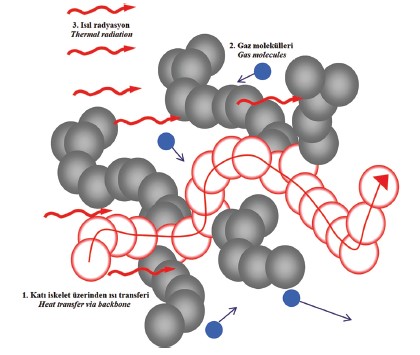Aerogels and their composites are known as ultralight (0.003-0.15 g/cm3) solid materials and also take place in many academic and industrial applications with unique features as their high porosity (80-99.8%) and high surface area (500-1200 m2/g).
Aerogels produced frequently by sol-gel method are obtained by using many different starting materials. It is possible to change the structural properties of aerogels such as pore size and surface area as desired, according to the type of raw material used and changes in the production parameters.
In addition, aerogels can be modified by adding different functional groups (amine groups, etc.) to provide the desired mechanical and physicochemical properties [1].
Aerogels can be used as an adsorbent due to its high surface area and porosity, it is used as insulation material due to its low thermal conductivity. In addition, due to its high surface active area and pore size, aerogels are used in catalysts and sensor technologies [2].
Thermal Insulation
Silica aerogels, the most commonly studied type of aerogel, have low thermal conductivity (0.02 W/mK) as they contain solid silica in a low proportion (1-10%) [2]. As the pore diameter of aerogel decreases, the conduction of the heat is reduced by the convection.
Heat conduction through radiation depends on scattering due to the particle boundaries of the porous material, the interface, absorption and emission [3]. Due to their high porosity and nanometric dimension of their pores, they have lower thermal conductivity coefficient than air.
1- Conduction heat transfer through solid skeleton:
The heat transfer on the solid skeleton is carried out by the phonon mechanism. Atomic vibrations are effective on the heat transfer in nano size. If the solid skeleton is finer, the heat transfer becomes less so. Therefore, low-density aerogels are thermally more successful.
2- Heat transfer with the gas phase in the pores:
According to the kinetic gas theory, gas molecules in the open air collide irregularly due to the average free path dimension. The average free path is the way for an atom or molecule to collide with another atom or molecule.
However, since the pore sizes in the aerogel are very small relative to the average free path measurement, the air molecules in the pore cannot collide as in the open air. Therefore, heat transfer coefficient of aerogel has been lower than air.
3- Radiation heat transfer:
The optical properties and optical thickness concepts of the aerogel are decisive. It is not satisfactory according to other heat transfer mechanisms. However, this barrier has been eliminated with some additives [5].
Figure 1. Heat transfer mechanisms within aerogel
Therefore, aerogels are one of the most suitable materials for thermal insulation. This makes silica aerogel a very economical and practical insulation material used in many different industries and areas.
In building, refrigerators and windows:
Silica aerogels are excellent insulating materials that can be used in insulating windows due to their production as a monolith, very low thermal conductivity, good thermal stability and their optical properties.
It can also be used as thermal and acoustic insulation materials in buildings and refrigerators. Silica aerogels can withstand very high temperatures, so building fires can also be prevented.
In Space:
Silica aerogels are particularly notable for their super insulation properties in aerospace applications. Aluminum silicate refractory fiber/silica aerospace composite developed by NASA Ames Research Center (U.S) was used in a composite space vehicle. Russian “Mir” space station also uses silica aerogels as insulation material.
Aerogel was used for insulation purposes in the Mars Exploration Vehicle. In order to capture comet particles, aerogels were used in the Stardust Spacecraft in order to collect the stardust and reach the world.
In Industry:
Usage of silica aerogels and composites in the petroleum, chemical and metallurgical industries, replacing conventional insulation materials in pipes, ovens and other thermal devices reduces heat loss, while also improving the use of thermal energy.
Also, it can be used as an insulating material in engines, vehicles and aircraft exhaust pipes.
Clothing and blankets:
Silica aerogels as insulation materials have found their place in some areas other than buildings, industries. They have different formulations designed for use in freezers, high temperatures and even winter clothing.
A flexible aerogel insulation blanket has been developed with the idea of a NASA engineer, to produce a flexible insulation material in order to provide insulation at a temperature of hundreds of degrees below zero in the liquid fuel storage and transfer tank [6].
Acoustic Insulation
In order to increase the living standards, increasing sound quality in residences is becoming more important. In planning architectural buildings such as music halls, multi-purpose halls and conference halls, systems with maximum sound characteristics must be used in accordance with the purpose.
Conventional sound absorbers such as glass wool, rock wool, urethane foam and foam in buildings and indoors have been associated with health and environmental problems as well as low insulation and flammability.
Therefore, it is necessary to have environmentally friendly materials with high flame resistance and high insulation, but also with good sound absorption properties [7].
Aerogels are materials with excellent advantages in sound insulation like other properties. Sound insulation in aerogel depends on aerogel density, air-filled cavities and the method of preparation.
The amount of sound emitted from the gas phase to the solid phase disappears. reductions in the amplitude and velocity of the sound waves occur. It is observed that the sound speed is reduced to 100 m/s. Thanks to this capability, silica aerogels can be seen as one of the most suitable materials for acoustic insulation.
It has a variable range of acoustic impedance and is used as acoustic impedance coupling material for ultrasonic detectors. Here, the acoustic impedance shows how much sound pressure is generated by the vibration of the molecules of a given acoustic environment at a given frequency [6].
Owing to their low sound velocity transmission properties, silica aerogels have proven to be used as an acoustic delay or as a good acoustic insulation material at high temperatures [8].
Silica aerogels can be used to provide insulation of footsteps by using flooring of houses. It can also be used as an insulating material in environments where the loud sound is needed, for example, to prevent sound from disturbing the surrounding people in concerts.
In addition, studies into the use of silica aerogels in soundproofing rooms are still in progress. Silica aerogels can be used as insulation material or as a filling material for interior and exterior paints and can be provided fireproof and high energy conservation buildings.
The use of silica aerogels, which are very light materials, in thermal and acoustic insulation will provide a great deal of energy savings compared to conventional insulating materials.

Burcu Karakuzu İkizler
R&D Engineer
Ömer Lütfü Özgül Kimyevi Maddeler
İthalat İhracat ve Ticaret A.Ş.

Emine Yapıcı
Bioengineer
Ömer Lütfü Özgül Kimyevi Maddeler
İthalat İhracat ve Ticaret A.Ş.

Prof. Dr. Sevil Yücel
R&D Advisor
Ömer Lütfü Özgül Kimyevi Maddeler
İthalat İhracat ve Ticaret A.Ş.
References
[1] Wang Q. et al., (2016). “Synthesis, characterization, and adsorption properties of silica aerogels crosslinked with diisocyanate under ambient drying,” Journal of Material Science.
[2] Gurav, J. L., Jung, I. K., Park, H. H., Kang, E. S., & Nadargi, D. Y. (2010). Silica aerogel: synthesis and applications. Journal of Nanomaterials, 2010, 23.
[3] Ülker Z., Sanli D., Erkey C., Applications of aerogels and their composites in energy-related Technologies, Chapter 8, Koç University, Turkey.
[4] Ebert, H.-P. (2015) ‘Functional materials for energy-efficient buildings’, EPJ Web of Conferences, 98, p. 08001.
[5] Ebert, H. P. (2011). Thermal properties of aerogels. In Aerogels handbook (pp. 537-564). Springer, New York, NY.
[6] Huang, L. (2012). Feasibility of using silica aerogel as insulation for buildings.
[7] Chandradass, J., Kang, S., & Bae, D. S. (2008). “Synthesis of silica aerogel blanket by ambient drying method using water glass based precursor and glass wool modified by alumina sol.” Journal of Non-Crystalline Solids, 354(34): 4115-4119.
[8] Hrubesh, L. W., 1998. Aerogel applications. Non-Crystalline Solids, 225(335-342), p. 8.





